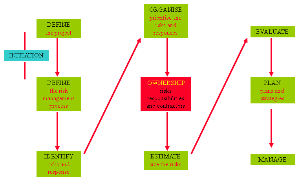Risk management - risks, responsibilities and contractors
The Risk Management process
OWNERSHIP (risks, responsibilities and contractors)
This is the area where the client can practice ‘risk evasion’. The aim of this phase is to clarify ownership of the risks either within the organisation or with other parties.
Remember that parting with risk in this manner does not mean that the risk has been avoided. It very much depends on whether the third party can manage risk adequately.
Any risks managed internally must have named individuals responsible for them.
External contractors may be identified to manage some of the risks.
- In general, this allocation should be legally enforceable within contractual terms and conditions.
- There should be a policy which looks at the reasons for allocating risk, to what particular third parties and what risks are allocated.
- Third parties may include insurance companies bearing some of the cost of the risk. The insurance company may require certain assurances that you will mitigate the risk impact by suitable plans.
- The policy should consider how these intentions are transferred into contracts.
Try to bear in mind that management of the risk is different to having accountability for the risk. Although you may pass on the risk to a contractor they may not be in the best position to suffer the consequences of failure financially. Contractors will be less inclined to manage a risk which may put them out of business. This aspect needs careful management if you are not to alienate contractors.
For example:
If a particular risk would cost £10M if it materialised but has a likelihood of happening of 25% then you may wish to add a ‘cost’ of £2.5M to the project manager’s budget.
However, the board may not be keen to add this amount to the budget. If they do and the risk does not materialise the budget has an excess of £2.5M which may be spent on other less efficient areas.
In this case, the board may wish to take direct responsibility for the risk relieving the project manager.
The project manager or contractor would still need to manage the risk in trying to avoid it occurring with proactive activities in the ‘base’ or ‘reference’ plan or formulate contingency plans in case the risk does materialise.
These considerations are reflected in ‘expected costs, contingency, target costs, provisions and commitments (see below), which are:
Expected costThe ‘expected cost’ is precisely that. It is the cost of the project if all goes to plan. This will include all identified risks which you expect to occur and thus have been allowed for within the management of the plan. Let us say that this is £180,000. The likelihood of meeting the expected cost may be 50 to 60%.
ContingencyFor those risks that could have a significant impact on the project that you hope do not, but may occur, you need to have contingency funds.
With the additional funds for contingency the chance for success is increased to around 80 to 90%.
The overall potential cost of a project may be £200,000 of which £180,000 is the expected cost and the other £20,000 is contingency.
However, the project manager may set a ‘target’ of less than £180,000 and retain say £25,000 as a ‘provision’.
This is the amount of funds ‘held back’ by the board as the difference between the ‘expected cost’ and the ‘target cost’.
CommitmentsThe sum of the ‘expected cost’ and the ‘contingency’ is a measure of the ‘commitment’ of senior managers to the project.
Remember, risk allocation to third parties has to be managed well as motivation and self interest are involved.
Often legal advisors may well try to promote as much risk allocation to third parties as possible which may not be an ideal situation.
The number of contractors and subcontractors involved in a project will vary with construction projects having a significant number.
Communication between all of the parties can add risk to the project.
Each project will need to allow sufficient time for contractors to put together bids, the selection period and then negotiation of the contracts.
Policies for handling selection and contracts need to be in place early whilst the actual process of selection and contract negotiation will come later.



